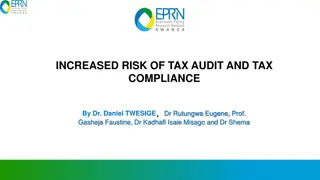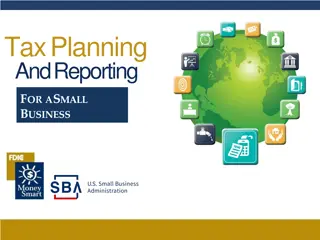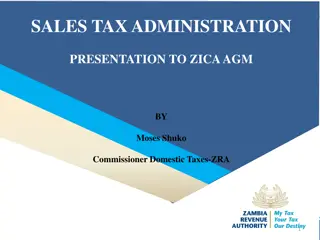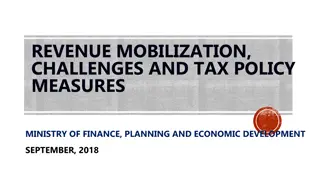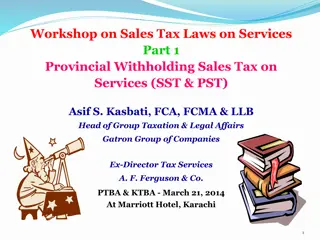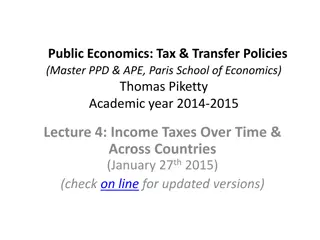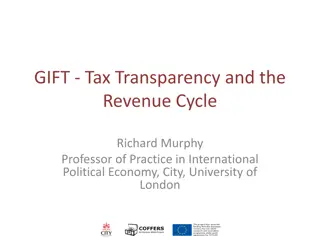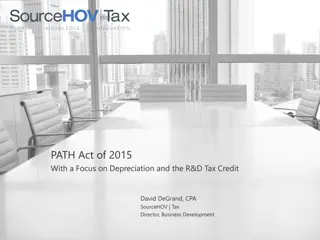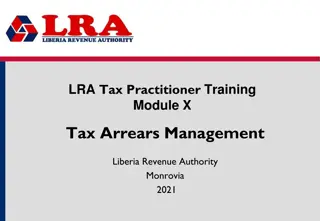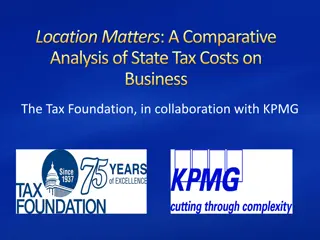Tax Policy and Market Efficiency
This PowerPoint material covers tax policy insights, market efficiency, consumer and producer surplus, economic equilibrium, and the role of the market in economic systems. It delves into government intervention and possible market problems like public goods and externalities.
Download Presentation

Please find below an Image/Link to download the presentation.
The content on the website is provided AS IS for your information and personal use only. It may not be sold, licensed, or shared on other websites without obtaining consent from the author.If you encounter any issues during the download, it is possible that the publisher has removed the file from their server.
You are allowed to download the files provided on this website for personal or commercial use, subject to the condition that they are used lawfully. All files are the property of their respective owners.
The content on the website is provided AS IS for your information and personal use only. It may not be sold, licensed, or shared on other websites without obtaining consent from the author.
E N D
Presentation Transcript
ECON 510 Tax Policy PowerPoint Material 2015 J. Fred Giertz Institute of Government and Public Affairs and Department of Economics University of Illinois at Urbana
Short On-Line Lectures Circular Flow (Khan Academy): https://www.khanacademy.org/economics-finance-domain/macroeconomics/gdp-topic/circular- econ-gdp-tutorial/v/circular-flow-of-income-and-expenditures Supply and Demand (Khan Academy): https://www.khanacademy.org/economics-finance-domain/microeconomics/supply-demand- equilibrium Consumer and Producer Surplus (Khan Academy) https://www.khanacademy.org/economics-finance-domain/microeconomics/consumer-producer- surplus/consumer-producer-surplus-tut
Role of the Market Decentralized system can lead to desirable results Economic efficiency Maximizing net benefits Consumer and producer surpluses Economic equilibrium Coincidence of equilibrium and efficiency Examples of inefficiency Equity
Evaluation of Market Efficiency Equity (fairness)
Review of Economic Efficiency and Market Equilibrium REVIEW http://upload.wikimedia.org/wikipedia/commons/thumb/d/d7/Economic-surpluses.svg/350px-Economic-surpluses.svg.png Marginal Cost Marginal Marginal Benefit
Examples of Inefficiency Price Ceiling http://www.economicshelp.org/microessays/markets/monopoly- diagram/
Possible Problems with Market (What is the role government in a private enterprise economy?) Philosophical issues Technical issues Public goods Externalities Incomplete Markets Imperfect information Asymmetric information Distribution Monopoly Macro issues stability and growth
Public Goods in More Detail Definition contrast with private goods Non-exclusion Non-rivalry Public goods vs. public production vs. public provision Why does the market fail? Free riding problems Non-exclusion Insignificance
Externalities in More Detail Externalities defined Negative such as pollution Positive such as education Why do they create problems for the market? Social costs vs. private costs Corrective actions Are they needed? What form should they take?
Externalities in More Detail Externalities defined Negative such as pollution Positive such as education Why do they create problems for the market? Social costs vs. private costs Private costs + external costs= social costs Private benefits + external benefits= social benefits Example of inefficiencies
Externalities (continued) Corrective actions Are they needed? (Pigou vs. Coase) What form should they take? Regulations Taxes and subsidies A market for externalities Firm A Level Firm B Level MB for A MB for B 0 1 2 3 4 5 6 7 0 1 2 3 4 5 6 7 60 50 40 30 20 10 0 22 18 14 10 6 2 0 Reduce total from 12 to 6
Introduction to Taxation Taxes are one way of financing government along with borrowing, fees & charges, etc. Basic criteria for evaluating taxation Efficiency Neutrality as a goal Do as little harm to the functioning of the private market Equity or fairness
Equity Equity is basically a normative or ethical concept Equity like beauty is in the eye of the beholder Components of equity Horizontal equity equal treatment of equals Vertical equity the appropriate differential treatment of unequal
Taxes vs. Fees Fees are related to prices for public services where exclusion is possible. Generally, the revenue generated by a fee is used to finance the activity. Fees are applications of the benefits- received theory In practice, the distinction is often not well defined.
Benefits-received vs. Ability-to-pay Benefits-received Advantages Mirrors private market? Provides incentives for citizens Disadvantages Difficult to apply in some cases Not useful for redistribution Ability-to-pay advantages and disadvantages
Letter to Editor Champaign News-Gazette May 17, 2010
Inclusive vs. Exclusive Rate Exclusive vs. Inclusive Rates Rates with equal revenue Equal Yield: Inclusive and Exclusive rates Inclusive Exclusive 1.4 Tax Rate Tax Rate Ratio 1.2 0.0% 5.0% 10.0% 15.0% 20.0% 25.0% 30.0% 35.0% 40.0% 45.0% 50.0% 55.0% 60.0% 65.0% 70.0% 75.0% 80.0% 85.0% 90.0% 95.0% 99.0% 0.0% 5.3% 11.1% 17.6% 25.0% 33.3% 42.9% 53.8% 66.7% 81.8% 100.0% 122.2% 150.0% 185.7% 233.3% 300.0% 400.0% 566.7% 900.0% 1900.0% 9900.0% 1.05 1.11 1.18 1.25 1.33 1.43 1.54 1.67 1.82 2.00 2.22 2.50 2.86 3.33 4.00 5.00 6.67 10.00 20.00 100.00 1 Exclusive Rate 0.8 0.6 0.4 0.2 0 0 0.1 0.2 0.3 0.4 0.5 0.6 Inclusive Rate Ti = (Te)/(1+Te)
Rationales for Progressivity Example Results Total Utility Marginal Utility Taxes $50 person $200 person $50 person $200 person $50 person $200 person Tax Rates Utility Income Compare 0 10 20 30 40 50 60 70 80 90 100 110 120 130 140 150 160 170 180 190 200 100 195 285 370 450 525 595 660 720 775 825 870 910 945 975 1000 1020 1035 1045 1050 100 95 90 85 80 75 70 65 60 55 50 45 40 35 30 25 20 15 10 Taxes needed = $40 Equal $ Proportional $ 16% $20 $8 $20 $32 40.0% 16.0% 10.0% 16.0% 165 U 64 U 15 U 34 U Minimum sacrifice Equal Sacrifice Proportional Sacrifice $0 $5 $40 $35 0.0% 10.0% 4.8% 20.0% 17.5% 18.8% 0 U 40U 45.15U 50 U 40U 19.35U $2.41 $37.575 What are the problems with this approach? Is utility measurable? Does MU decline? Can you compare utility among persons? 5
Measuring Progressivity Flat Rate Flat Rate with 10,000 Lump Sum Average Rate ERR 10.00% 10.00% 10.00% 10.00% 10.00% 10.00% 10.00% 10.00% 10.00% 10.00% Exempt Average Rate ERR 0.00% 5.00% 6.67% 7.50% 8.00% 8.33% 8.57% 8.75% 8.89% 9.00% Average Rate Income Income 0 10000 20000 30000 40000 50000 60000 70000 80000 90000 100000 10% Tax Tax Income Tax Income Income Tax 1000 1000 1000 1000 1000 1000 1000 1000 1000 1000 1000 0 0 0 0 0 1000 2000 3000 4000 5000 6000 7000 8000 9000 10000 10000 20000 30000 40000 50000 60000 70000 80000 90000 100000 10000 20000 30000 40000 50000 60000 70000 80000 90000 100000 10.00% 5.00% 3.33% 2.50% 2.00% 1.67% 1.43% 1.25% 1.11% 1.00% 1000 2000 3000 4000 5000 6000 7000 8000 9000 10% Tax Income Consump. 3000 11000 19000 27000 35000 43000 51000 59000 67000 75000 83000 Tax 300 1100 1900 2700 3500 4300 5100 5900 6700 7500 8300 AR Income Income Tax AR 0 ERR 0 0 10000 20000 30000 40000 50000 60000 70000 80000 90000 100000 11.00% 9.50% 9.00% 8.75% 8.60% 8.50% 8.43% 8.38% 8.33% 8.30% 10000 20000 30000 40000 50000 60000 70000 80000 90000 100000 1000 2500 4500 6500 9000 11500 14000 16500 19000 21500 10.00% 12.50% 15.00% 16.25% 18.00% 19.17% 20.00% 20.63% 21.11% 21.50% Tax = 10% of consumption Consumption= 3000+.8*Income Tax Brackets 0-10,000 0-10,000 10-20,000 10-20,000 1,000+15% 20-40,000 2,500+20% > 40,000 10% 6,500+25%-------------------
Gini Coefficient = A/(A+B) G=0; Complete Equality G=1; Complete Inequality
Tax Avoidance, Evasion and Deliquency Economics of crime Benefits Costs Direct costs Probability of arrest and conviction Severity of punishment Economics of evasion Benefits taxes saved Costs Direct costs Psychic costs Probability of detection Severity of punishment
Tax Rates and Tax Revenues Visualizing the Laffer Curve Laffer Curve Tax rates and Tax Revenues Are tax revenues proportional to tax rates? The example of a tariff? Elasticity issues Cigarettes? A tax on Cokes vs. a tax on soft drinks? The Laffer curve Dynamic scoring Short run Long run Adjustments example of income tax
Tax Expenditures Tax expenditures are revenue losses attributable to tax provisions that often result from the use of the tax system to promote social goals without incurring direct expenditures. How tax expenditures are structured affects both who will benefit from them and how much they will reduce federal revenues.
Partial equilibrium approach The excise tax example Selective excise Specific (unit) vs. ad valorem Is the tax applied on the consumer or the producer? Different approaches Same results
Excise tax incidence--examples Basic example sharing the price burden Consumer and producer price burden Equivalence of consumer and producer imposition Short run and long run Special cases Inelastic supply Inelastic demand Elastic supply
Taxation and efficiency Review of efficiency concept Welfare cost and excess burden The excise example once again Basic case Tax revenues Welfare cost s Special cases Inelastic supply Inelastic demand
Tax rates and tax revenues Are tax revenues proportional to tax rates? The example of a tariff? Elasticity issues Cigarettes? A tax on Cokes vs. a tax on soft drinks? The Laffer curve Dynamic scoring Short run Long run Adjustments example of income tax
Individual Income Taxation Definition of income Measure of ability-to-pay Haig-Simons, Accretion concept, Comprehensive Income, Economic income Income may be defined as the algebraic sum of the market value of rights exercised in consumption plus the change in value of the store of property rights between the beginning and end of the period in question. Simons Income = Consumption + Change in Wealth
Calculation of Income I 100 110 90 C 100 100 100 NW0 50 40 60 NW1 50 50 50
Individual Income Taxation (continued) Other definitions Legal (AGI) Income as production Income vs. consumption (a first look) Income = Consumption + Saving Income Consumption = Saving The issue is the tax treatment of savings
Applications of the Haig-Simons Definition Wages H-S income The corporate income (Disc. Later) Retained earnings (Discussed later) Employee-paid safety equipment Excludable H-S income Social Security payments H-S income Death transfers H-S income Gifts H-S income Employer-paid education (Depends on purpose) Unemployment Compensation H-S income Housing owning vs. renting Net imputed rent H-S income Bequests H-S income to heirs Employer-paid vacation H-S income Interest H-S income (real return only) Owning vs. leasing a car Employer-paid insurance H-S income Travel expenses for sales person Excludable H-S income Dividends H-S income (real return only) Inflationary wage increases H-S income (with indexation) Capital gains H-S income (real return only) Employer-paid pension contributions H-S income (real return only) Education expenses not employer paid (Depends on purpose) Child care ???? Business class air travel for business purposes (Depends on purpose) Free checking accounts (tax Interest, charge for checking)
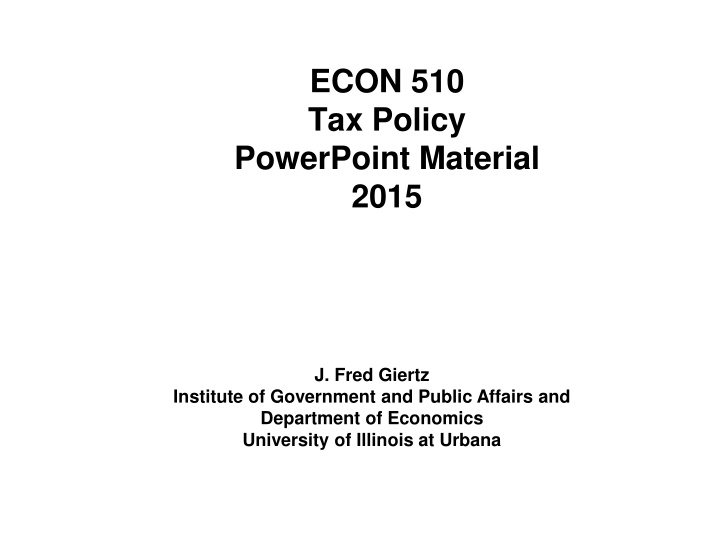


![Town of [Town Name] Real Estate Tax Rates and FY 2024 Budget Summary](/thumb/62211/town-of-town-name-real-estate-tax-rates-and-fy-2024-budget-summary.jpg)
